DEAR KEITH,
I WILL DIG UP WHAT PHOTOS I HAVE AND EMAIL TO YOU FOR INCLUSION. I HAVE A 1934 2 SEAT LONG FOUR BASED SPECIAL AND A 1934 (1935 SPEC) KESTREL, BOTH IN PERFECT CONDITION.
LIVING IN INDONESIA, WITH THE CARS IN THE UK, THEY DO NOT GET THE USE THAT THEY DESERVE, AND DUE TO LACK OF TIME DUE TO BUSINESS, I HAVE NOT HAD THE CHANCE OF GETTING BACK VERY OFTEN.
HOWEVER, HOPEFULLY 2001 AND 2002 WILL BE KINDER AND WE HOPE TO SPEND MORE TIME WITH THE CARS.
I WOULD LOVE TO DO SOME
JOWETT MOTOR SPORT (MY OTHER CARS ARE EX-WORKS GROUP B RALLY CARS - LANCIA 037,
A1 AUDI QUATTRO AND NISSAN 240RS) AND PROBABLY NORMAN IS THE BEST BET, BUT IT
ALL DEPENDS ON WHAT YOU DEFINE AS MOTOR SPORT AND TIME.
THANKS FOR THE STERLING EFFORT ON THE SITE, AND LETS KEEP IN TOUCH.
BEST REGARDS
FRED & RIA HOLLOWAY
Twin Brothers
In the mid 1930’s, Jowett Motor Cars of Bradford produced a range of cars and commercial vehicles. All utilised their famous twin cylinder, horizontally opposed, water-cooled engine (flat twin). The passenger vehicles offered were a four-door saloon (in different levels of trim and in 4 light and 6 light configuration), and a pair of two-door tourers, one having four seats and one having two seats (on a shortened chassis). All bodies were of the traditional ash frame design, with bodywork in cloth in a steel and aluminium blend. Jowett in the early 30’s offered cloth covered bodywork (cloth over marine ply), but by 1934 this option dropped.
In mid 1934, for the 1935 range of models, Jowett changed the design of the long wheel base chassis, from a conventional ladder chassis to a cruciform chassis. The cruciform chassis gave better torsional rigidity. Other small changes were also accommodated, one major modification was to move the accelerator pedal, previously in the middle, to the by then conventionally accepted, right. The 4 light option on the saloons ceased.
Norman, the two-seat roadster registration number KFF 168, was designed by me, in sympathy with contemporary designs from other sports car manufacturers. Construction took two years. The car is based on a 1934 Jowett Long Four saloon chassis, engine and running gear. Being registered on the 12th May 1934, the chassis is of the earlier design. This decision was taken due to the fact that the ladder type chassis lends itself better to a special rather than the more complicated cruciform type.
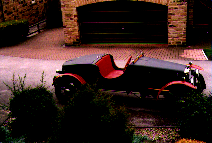
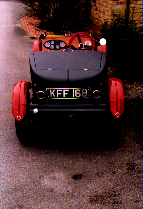
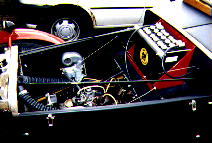
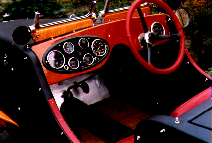
The body is a traditional ash frame utilising cloth over marine ply technology. The cloth is a modern equivalent to the original, being black. Red painted Bugatti front and rear wings cover the original wire wheels. Inside, the less than spacious cockpit is trimmed in red leather. The steering wheel is a red leather covered standard item. The dashboard retains some originality, utilising the standard instrumentation cluster, moved off centre from that in the saloons. A period rev-counter is installed.
Fitted leather luggage has been designed for the small boot (accessed using the rear hinged cover), which is above the spare wheel storage space (accessed from a low rear cover holding the number plate and rear lights).
Aero screens and a tonneau cover
complete the weather protection. Flying helmet, gloves and sheepskin flying
jacket seem to be mandatory.
Apart from the engine, all mechanical systems are standard.
The engine was up-rated from the original 907 cc (7 HP) to a stonking 946 cc (8 HP) through utilisation of the 1936 specification 8 HP barrels/pistons. The pistons have been modified to obtain a higher compression ratio (standard being about 6.5:1), the cam slightly re-profiled, a lightened flywheel fitted together with twin carburettors. The engine output is estimated at 24 bhp, putting out about 30% more power than the standard 7 HP.
Since the body is somewhat lower than standard, the engine, gearbox, and drive train had to be lowered by about 6 inches to accommodate the steering column. These are rigid columns with no universal joints, and since the column runs over the top of the flat twin engine, the only way to reduce the column height was to drop the engine. The 1934 radiator (a slightly tapered design) was replaced by the rectangular 1930 radiator to improve appearances.
The brakes are standard four-wheel rod operated. The hand brake operates on all four wheels.
The exact weight of the car is unknown, but estimated at about 600 Kg.
Top speed (to date) is about 55 mph (down hill with a following wind).
Acceleration data is unknown (but not quick).
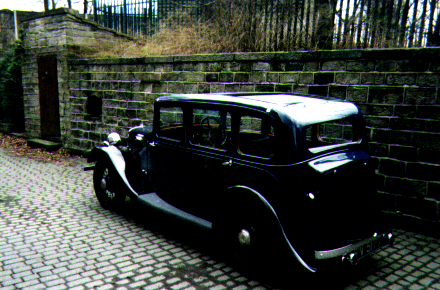
Although registered in 1934 (1st October 1934) Stanley, registration number FV 5177, is a 1935 specification Kestrel (six light four door saloon) and hence was one of the first of the new cruciform design models. The four-seat saloon is an ash framed body of steel and aluminium. The spare wheel is located at the back of the car, being accessed from a bottom hinged, rear “boot” lid (unlike the earlier models where the spare is bolted to the rear body panel), whilst luggage is carried in the area to the front of the spare wheel (accessed by lifting the rear seat back rest) and by using the boot lid as a platform, which can be locked open.
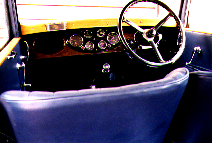
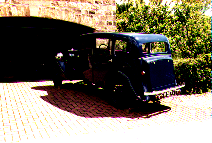
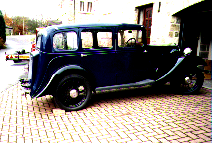
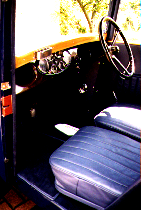
The car is totally original and unmodified (with the exception of leather upholstery, which was only offered on the higher specification Curlew, where the Kestrel had rexine or moquette) having been restored to an exceptionally high standard over a three-year period. The coachwork is the original dark blue over black wings, with mid-blue leather upholstery.
As standard, the car has a fully opening sunshine roof. Front doors are of the typical “suicide” design predominant at that time. The both front and rear doors are hinged from the centre pillar of the body.
All mechanical systems,
including the engine are original and standard.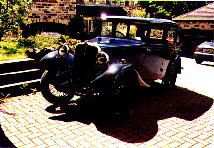
The 1935-specification engine is a 907 cc (7 HP) single carburettor, horizontally opposed twin.
Road reports of the time report the following:
Top speed = 50 mph
Maximum speeds through the gears: 1st = 15 mph; 2nd = 25 mph; 3rd = 38 mph.
Acceleration: 20-40 mph in 3rd = 20 seconds
The brakes are standard four-wheel rod operated. The hand brake operates on all four wheels.
The exact weight of the car is about 800 Kg, making it quite a heavy car for such a small engine, although one of Jowett’s selling points was its roominess compared with its competitors (for example the Austin 7, which is tiny in comparison)
Top speed (to date) is about 45 mph (down hill with a following wind), but the engine is still running in.
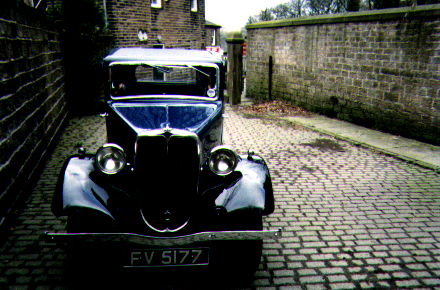
My father
had a 1935 Kestrel, which he bought for £20 in 1957, and sold for 30 shillings
(£1.50) in 1961 (I think). My mother learnt to drive in it. We used to go every
where in that car. We used to go up the Sussex South Downs in it along the chalk
tracks and I would play with my Dinky toys. At Christmas, we used to go down the
lanes and pick the holly through the sliding roof. Incidentally, in a Jowett
Book there is a picture of a Lady doing exactly the same thing.
Why the
name Norman? Well, driving north from London some years ago, I passed a lorry
belonging to a haulage company based in Yorkshire, with the name of Norman
Jowett. Hence the long four that was used as the basis for Norman was given that
name at that time.
My
father’s nickname was Stanley (after the music hall singer Stanley Holloway).
So in memory of my father, I chose the name Stanley.